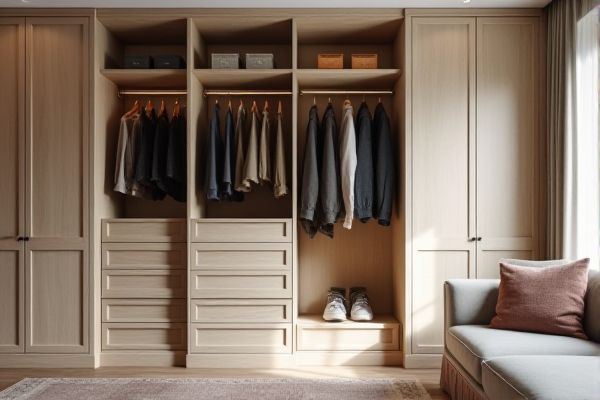
Built-in closets maximize space efficiency by customizing storage to your room's dimensions, offering a seamless and integrated look that can increase home value. Explore the rest of the article to discover which option suits your lifestyle and space requirements best.
Table of Comparison
| Feature | Built-in Closet | Freestanding Wardrobe |
|---|---|---|
| Installation | Permanent, custom-built | Portable, no installation required |
| Space Utilization | Optimizes room layout, fits wall dimensions | Limited by wardrobe size and shape |
| Customization | High, tailored to needs and design | Low to moderate, pre-designed models |
| Cost | Higher initial investment | Generally affordable |
| Durability | Long-lasting, built-in materials | Varies, often less sturdy |
| Flexibility | Fixed location, hard to relocate | Easy to move and rearrange |
| Maintenance | Low maintenance once installed | Requires regular cleaning and care |
| Aesthetic Appeal | Sleek, integrates with room design | Varies, can be stylish but bulky |
Overview: Built-in Closet vs Freestanding Wardrobe
Built-in closets maximize space efficiency by customizing storage to your room's dimensions, often featuring integrated shelves, drawers, and hanging areas tailored to your needs. Freestanding wardrobes provide flexibility with easier relocation and diverse styles but may occupy more floor space and lack seamless integration. Choosing between the two depends on your room layout, storage requirements, and design preferences to optimize organization and aesthetics.
Space Efficiency: Maximizing Room Layout
Built-in closets maximize space efficiency by seamlessly integrating into room architecture, utilizing every inch from floor to ceiling and wall to wall. Unlike freestanding wardrobes, built-ins often include customizable compartments tailored to specific storage needs, reducing wasted space around bulky furniture. This approach enhances room layout by offering a sleek, unobtrusive solution that frees up valuable floor area and improves overall room flow.
Design Flexibility and Customization
Built-in closets offer unparalleled design flexibility and customization by seamlessly integrating into existing architecture, allowing for tailored dimensions, materials, and organizational features to maximize space efficiency. Freestanding wardrobes provide versatility in style and placement but often come with fixed sizes and limited customization options compared to built-in solutions. Choosing between the two depends on the need for personalized storage configurations versus ease of relocation and design variety.
Installation and Setup Process
Built-in closets require professional installation involving precise measurements, wall modifications, and custom fitting to maximize space efficiency. Freestanding wardrobes offer a simpler setup, allowing you to quickly assemble and place them without permanent alterations to your room. Your choice between these options depends on how much time and effort you want to invest in installation and whether you prefer a fixed or movable storage solution.
Cost Comparison: Budget Considerations
Built-in closets generally have higher upfront costs due to custom design, materials, and installation fees, but they offer long-term value by maximizing space and increasing home resale value. Freestanding wardrobes are more budget-friendly initially, with lower purchase prices and no installation expenses, making them ideal for renters or those with limited budgets. Choosing between the two depends on balancing immediate affordability against durable investment and spatial efficiency.
Storage Capacity and Organization
Built-in closets maximize storage capacity by utilizing every inch of available space, often featuring custom shelving, drawers, and compartments tailored to your needs. Freestanding wardrobes offer flexible organization options but typically provide less efficient use of space due to fixed dimensions and limited customization. Your choice impacts how effectively you can organize clothing, accessories, and other items for easy access and optimal storage.
Mobility and Relocation Benefits
Freestanding wardrobes offer greater mobility and ease of relocation compared to built-in closets, allowing you to move or rearrange your storage effortlessly when changing homes or updating room layouts. Built-in closets are fixed structures that provide a seamless, customized fit but lack portability, making relocation challenging and often requiring professional dismantling. Choosing a freestanding wardrobe enhances flexibility for your evolving needs while built-in closets maximize space efficiency and design integration.
Durability and Maintenance
Built-in closets offer superior durability due to their fixed installation, often constructed with robust materials integrated into your home's structure, minimizing wear and tear. Freestanding wardrobes, while easier to move and replace, typically require more frequent maintenance to address issues like wobbly legs or surface scratches. Your choice impacts long-term upkeep, with built-ins generally demanding less maintenance and providing greater longevity.
Aesthetic Impact on Interior Design
Built-in closets create a sleek, seamless look by integrating directly into the wall, maximizing space and contributing to a minimalist aesthetic favored in modern interior design. Freestanding wardrobes offer versatility and can serve as statement pieces with decorative finishes, complementing various styles from vintage to contemporary. The choice between built-in and freestanding significantly influences room flow, visual openness, and the overall balance of furniture within the space.
Resale Value and Long-term Investment
Built-in closets often enhance resale value by maximizing space efficiency and providing a seamless, customized look that appeals to homebuyers. Freestanding wardrobes offer flexibility and are less expensive upfront, but they may not add the same long-term investment value as built-ins. Choosing built-in options can be a strategic decision to increase property appeal and overall market value.
 homyna.com
homyna.com